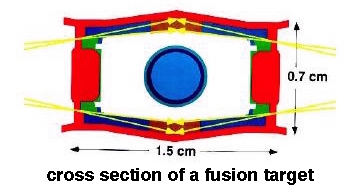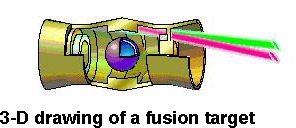HIF TargetWork
 Since the beam power and
intensity of present accelerators for heavy-ion fusion are
orders of magnitude below values required to ignite a
capsule, target-design research in the US is aimed at
improving the target performance in numerical
simulations. In an indirect-drive target, ion beams are
absorbed by a cylindrical metal shell, called a
Hohlraum, surrounding the fuel capsule, and the energy
is reradiated as X rays. These X rays would then heat
and compress the capsule, producing a hot region at the
center that would initiate the fusion reaction. The
X-ray intensity around the capsule must be very symmetrical
to avoid hydrodynamic instabilities during compression.
Earlier designs had radiators at the the ends of the
Holhraum, but it proved difficult to maintain adequate X-ray
symmetry with this geometry. During the last several
years, target physicists have developed a new family of
designs in which the ion beams are absorbed in the Hohlraum
walls, so that X rays are radiated from a large fraction of
the solid angle surrounding the capsule. With a
judicious choice of absorbing materials, this arrangement,
referred to as a "distributed-radiator" target, gives better
X-ray symmetry and target gain in simulations than earlier
designs. A typical distributed-radiator target is shown
in the two sketches here.
Since the beam power and
intensity of present accelerators for heavy-ion fusion are
orders of magnitude below values required to ignite a
capsule, target-design research in the US is aimed at
improving the target performance in numerical
simulations. In an indirect-drive target, ion beams are
absorbed by a cylindrical metal shell, called a
Hohlraum, surrounding the fuel capsule, and the energy
is reradiated as X rays. These X rays would then heat
and compress the capsule, producing a hot region at the
center that would initiate the fusion reaction. The
X-ray intensity around the capsule must be very symmetrical
to avoid hydrodynamic instabilities during compression.
Earlier designs had radiators at the the ends of the
Holhraum, but it proved difficult to maintain adequate X-ray
symmetry with this geometry. During the last several
years, target physicists have developed a new family of
designs in which the ion beams are absorbed in the Hohlraum
walls, so that X rays are radiated from a large fraction of
the solid angle surrounding the capsule. With a
judicious choice of absorbing materials, this arrangement,
referred to as a "distributed-radiator" target, gives better
X-ray symmetry and target gain in simulations than earlier
designs. A typical distributed-radiator target is shown
in the two sketches here.
 The earliest
distributed-radiator targets had three principal
shortcomings: the rather high energy input (about 6
MJ), the small beam spot size (about 3 mm), and the need for
"foot" pulses at a lower ion energy to heat the Hohlraum
before the arrival of the main pulses. Subsequent work
has made important progress in the first two of these
problems. The "close-coupled" target, first reported in
1999, reduced total beam energy by 40%, to 3.5 MJ, by
reducing the size of the Hohlraum while driving the same
capsule. Work on a "hybrid" target, which combines
aspects of the end-radiator and distributed-radiator designs,
has been underway since 2000 and, if successful, might allow
a spot size of nearly 5 mm. The principal difficulty in
this work is developing a design that allows beams to
approach the target from acceptably large angles. The
problem of an energy difference between the "foot" and main
pulses is more intractable. The energy difference is
needed because the range of ions in a material decreases as
the material is heated, so higher-energy ions are needed
later in the heating sequence for the beams to deposit their
energy at the same depth as earlier pulses. Delivering
pulses at two energies is nonetheless possible and at worst
introduces some added complexity near the end of the
accelerator.
The earliest
distributed-radiator targets had three principal
shortcomings: the rather high energy input (about 6
MJ), the small beam spot size (about 3 mm), and the need for
"foot" pulses at a lower ion energy to heat the Hohlraum
before the arrival of the main pulses. Subsequent work
has made important progress in the first two of these
problems. The "close-coupled" target, first reported in
1999, reduced total beam energy by 40%, to 3.5 MJ, by
reducing the size of the Hohlraum while driving the same
capsule. Work on a "hybrid" target, which combines
aspects of the end-radiator and distributed-radiator designs,
has been underway since 2000 and, if successful, might allow
a spot size of nearly 5 mm. The principal difficulty in
this work is developing a design that allows beams to
approach the target from acceptably large angles. The
problem of an energy difference between the "foot" and main
pulses is more intractable. The energy difference is
needed because the range of ions in a material decreases as
the material is heated, so higher-energy ions are needed
later in the heating sequence for the beams to deposit their
energy at the same depth as earlier pulses. Delivering
pulses at two energies is nonetheless possible and at worst
introduces some added complexity near the end of the
accelerator.
Current target simulations have several goals, all related to improving the match between target requirement and the parameters of feasible driver beams:
- Reducing or eliminating the difference in ion energy between the "foot" pulses and the main pulses.
- Increasing the allowable spot size of beams on the target.
- Modifying targets so that beams can approach at larger angles to the target axis.
- Reducing the sensitivity of targets to beam non-idealities, such as transverse offset, energy and current variations, and density non-uniformities.
references
J. Lindl, "Development of the Indirect-Drive Approach to Inertial Confinement Fusion and the Target Physics Basis for Ignition and Gain," Phys. Plasmas 2, 3933 (1995).
D. A. Callahan-Miller and M. Tabak, "A Distributed Radiator, Heavy Ion Target Driven by Gaussian Beams in a Multibeam Illumination Geometry," Nuclear Fusion 39, 883 (1999).
D. A. Callahan-Miller and M. Tabak, "Increasing the
Coupling Efficiency in a Heavy Ion, Inertial Confinement
Fusion Target," Nuclear Fusion 39, 1547
(1999).
For comments or questions contact WMSharp@lbl.gov or DPGrote@lbl.gov. Work described here was supported by the Office of Fusion Energy at the US Department of Energy under contracts DE-AC03-76SF00098 and W-7405-ENG-48. This document was last revised June, 2002.
